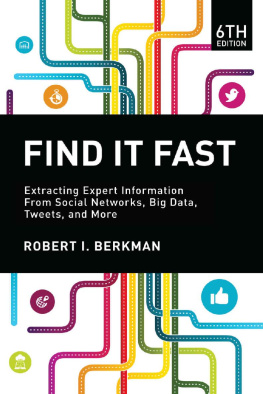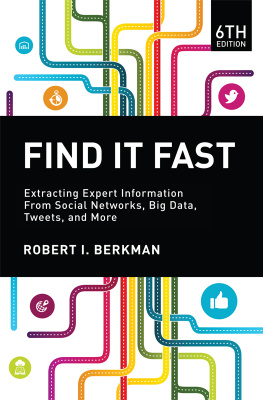FIND IT FAST
Extracting Expert Information From Social Networks, Big Data, Tweets, and More
ROBERT I. BERKMAN

First printing
Find It Fast, Sixth Edition: Extracting Expert Information From Social Networks, Big Data, Tweets, and More
Copyright 2015 by Robert I. Berkman
All rights reserved. No part of this book may be reproduced in any form or by any electronic or mechanical means including information storage and retrieval systems without permission in writing from the publisher, except by a reviewer, who may quote brief passages in a review. Published by Information Today, Inc., 143 Old Marlton Pike, Medford, New Jersey 08055.
Publishers Note: The author and publisher have taken care in the preparation of this book but make no expressed or implied warranty of any kind and assume no responsibility for errors or omissions. No liability is assumed for incidental or consequential damages in connection with or arising out of the use of the information contained herein.
Many of the designations used by manufacturers and sellers to distinguish their products are claimed as trademarks. Where those designations appear in this book and Information Today, Inc. was aware of a trademark claim, the designations have been printed with initial capital letters.
Library of Congress Cataloging-in-Publication Data
Berkman, Robert I.
Find it fast : extracting expert information from social networks, big data, tweets, and more / Robert I. Berkman. Sixth edition.
pages cm
ISBN 978-1-937290-04-7 (paperback)
1. Information retrieval. 2. Research. 3. Internet searching. 4. Search engines. 5. Information resourcesEvaluation. I. Title.
ZA3075.B47 2015
025.0425dc23
2015019680
Printed and bound in the United States of America
President and CEO: Thomas H. Hogan, Sr.
Editor-in-Chief and Publisher: John B. Bryans
Associate Editor: Beverly M. Michaels
Production Manager: Tiffany Chamenko
Indexer: Nan Badgett
Interior Design by Amnet Systems
Cover Design by Alison Gallagher-Rehn
infotoday.com
To Sol, Pat, Budd, and Don
Contents
Tables
Id like to express my gratitude to the many people who in one way or another played a big part in making this book come to pass, from the first edition published in 1987 through this one, the sixth.
My wife, Mary Walsh, gave me encouragement at the most critical momentswithout it the book would not have been written. George Finnegan has been a true mentor. Ill always be thankful for the chance to have worked for him which was a once-in-a-lifetime learning opportunity. Janet Goldstein, my first editor at HarperCollins, believed enough in the book to give it a chance and always provided support and great ideas.
Nancy Brandwein, Ken Coughlin, and Lilli Warren all offered critical insights, suggestions, and critiques of the original manuscript. Those who assisted with past editions include Sandy Gollop, Debbie Cohen, Ginny Fisher, Leigh Woods, Hella Rader, Cindy Pereiri, Jeff Goodman, Pam Goodman, Marie Kotas, and Trisha Karsay. Thanks are also due to Sasha Mishkin for her valuable help with the new edition.
Im very appreciative of my colleagues at Information Today, Inc., particularly my editor John B. Bryans for helping get this 6th edition published after a 15-year hiatus from the 5th. Ive been fortunate to have a helpful and encouraging team to work with for many years, publishing my books and the monthly research journal I co-edit, and supporting my other professional endeavors. I also want to note my appreciation for the excellent work of Beverly Michaels for her careful reading of the latest manuscript and her vital observations and questions that helped shape it into a better book.
A special thank you goes to everyone in the Norris family for providing me with such a beautiful and relaxing spot in which to write the first edition, in North Truro on Cape Cod.
Finally, thanks to my parents and brothers for their love, support, and invaluable ideas.
Its simple to go on the web and find information. So why would you need a book about doing research?
Perhaps if you Google that question youll find the answer.
Actually... no. Googling that question wont get you a good answer. There are, in fact, still countless queries and information problems for which the answer wont be found via Google. Or Wikipedia. Or Twitter. And thats one of the points of this newly revised book on how to find credible information and perform good research.
Find It Fast, first published in 1987, was last revised for its fifth edition in the year 2000. Thats eons ago in the information world, and an awful lot has happened in that world since then. For example Web 2.0, Wikipedia, Twitter, citizen reporting, sentiment detection, real-time search, social media, Google+, Pinterest, Instagram, Tumblr, YouTube, Vine, tagging, cloud collaboration, the wisdom of crowds, collaborative filtering, LinkedIn, Klout, Siri, Snapchat, social media monitoring, Facebook, Foursquare, and Flickrand more!
Back in the year 2000, all those concepts and sites were either not around or barely emerging. Thats an enormous amount of change in the information world.
But a lot has not changedspecifically, the elements of doing good research. For example, understanding how sources differ, knowing which resources to use, finding and evaluating experts, verifying information, understanding surveys, controlling ones biases, asking the right questions, assessing source credibility, disregarding the noise, understanding whats truly significant, and knowing when to conclude a project.
The More Things Change...?
Can we say, then, that doing good research has not fundamentally changed, but that the sources, tools, and strategies have changed?
Well, not quite. Not only have the sources, tools, and strategies clearly changed, they have, in fact, changed so dramatically that they have produced a revolutionary rethinking in many aspects of what constitutes good research.
Why are these changes truly revolutionary? We have to start by looking back to the mid-1990s, with the arrival of the internet, of course, which demolished the high barriers to entry for becoming a publisher. The last time we had a change that revolutionary for creating and distributing information was over 600 years ago when a German by the name of Johannes Gutenberg came up with the concept of movable type.
By the early 2000s we saw the emergence of the social webor Web 2.0 as it was then known. Initially, interaction on the web was primarily in the form of blogs, but this innovation was quickly followed by an explosion of other two-way information-sharing platforms: Flickr, YouTube, Tumblr, MySpace, Facebook, and many others. The social web permitted anyone to share his or her opinions, knowledge, and content, and to become part of a larger global conversation. As a result, we have all had to rethink some fundamental assumptions about what constitutes a credible source and, therefore, what it means to do good research.






